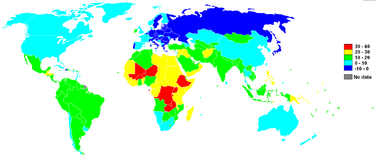Rate of natural increase

In demographics, the rate of natural increase (RNI) is the crude birth rate minus the crude death rate. When looking at countries, it gives an idea of what position in the Demographic Transition Model, but to find out how much a country is growing, the population growth rate should be observed.
Usually developing countries have a positive or high natural increase rate. Developed countries have a negative/neutral or low natural increase rate,[1] but many developed countries have their population increasing due to immigration despite their negative RNI.
The formula for the rate of natural increase is:
- (Crude birth rate − Crude death rate) / 10, where birth and death rates are in per thousand.
The result is the rate of natural increase in percentage form.
For example, Madagascar's crude birth rate (37.89) minus the crude death rate (7.97) is 29.92; divide that by 10 and the result is 2.992%, Madagascar's rate of natural increase.
See also
References
| Wikimedia Commons has media related to Rates of natural increase. |
World RNI is about 1.2%
External links
List of current RNI in world states http://hdrstats.undp.org/en/indicators/138.html